CTOR or click-to-open rate is an email marketing metric that helps you monitor your subscribers’ engagement with your content. CTOR is a ratio between the number of unique email opens and the number of clicks on the links within your emails.
An email campaigns’ efficiency depends on subscriber engagement, the number of recipients, time of the year, and many other factors. The open rate and click-through rate only partially measure user engagement. To have a better idea of how your emails perform, you need to use the click-to-open rate.
Why is tracking your CTOR important?
CTOR is among the most crucial marketing metrics because it allows marketers to analyze your content quality and understand if it meets user expectations. That’s because this metric only considers users who open emails, thus they are interested from the beginning. If your CTOR shrinks, it means the content is poor or your offers are irrelevant.
Let’s analyze the graph provided by MarketingLand, which shows the performance of three different campaigns. Email 3 seems to be the most successful, Email 1 is less effective, and Email 2 is a complete failure. This is true only from the quantitative side of things. If we talk about the content and creative quality measured by CTOR, we can see that Email 2 outperforms Email 1, though it has lower open rates and a lower CTR. That’s because Email 2 has a higher CTOR, thus we know it is more engaging and has more relevant content.
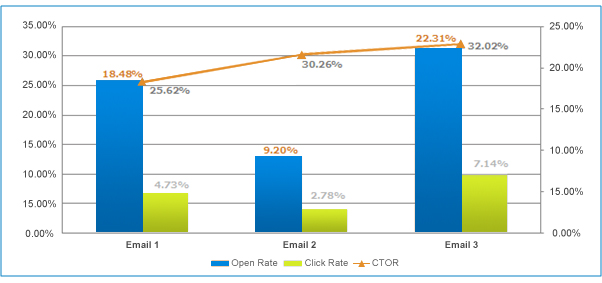
Email 2 was sent to a larger mailing list, which included unengaged subscribers. This caused a drop in opens and resulted in a lower click-through rate. By tracking CTOR, you can see that subscribers who opened Email 2 were more engaged compared to the user engagement with Email 1, which was sent to a regular mailing list. If you overlook the CTOR and only analyze CTR, you can miss such a change and misjudge Email 2 as a disaster.
However, in most cases, CTOR correlates proportionally to click-through rate. The second graph compares metrics of eight consistent email campaigns. In this case, the CTOR is a reflection of the CTR results.
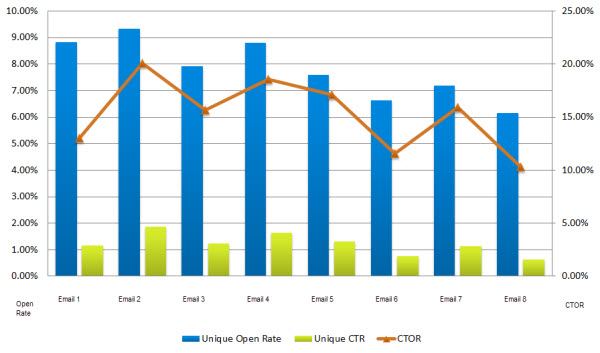
As you can see, this metric can be crucial in some cases, so it’s essential to back up your standard metrics, like open rate and CTR with CTOR. Let’s learn to measure the click-to-open rate.
How to Calculate a CTOR
To calculate this metric, you need to divide the number of unique clicks by the number of unique opens and multiply by 100 to get a percentage. Here’s the formula for a click-to-open rate:
CTOR = № of unique clicks / № of unique opens x 100.
If your email has 525 unique opens and 35 unique clicks, the CTOR is 6.67%. Now, let’s find out what to consider a healthy click-to-open rate.
What is the average CTOR?
Like other email marketing metrics, a “good” CTOR varies from industry to industry. Here’s Campaign Monitor’s report on various industry average metrics, including a click-to-open rate. It claims that the largest CTOR, above 15%, is seen in media, entertainment, publishing, and retail industries. In contrast, the lowest CTOR, below 10%, is seen in automotive, food and beverage, and professional services.
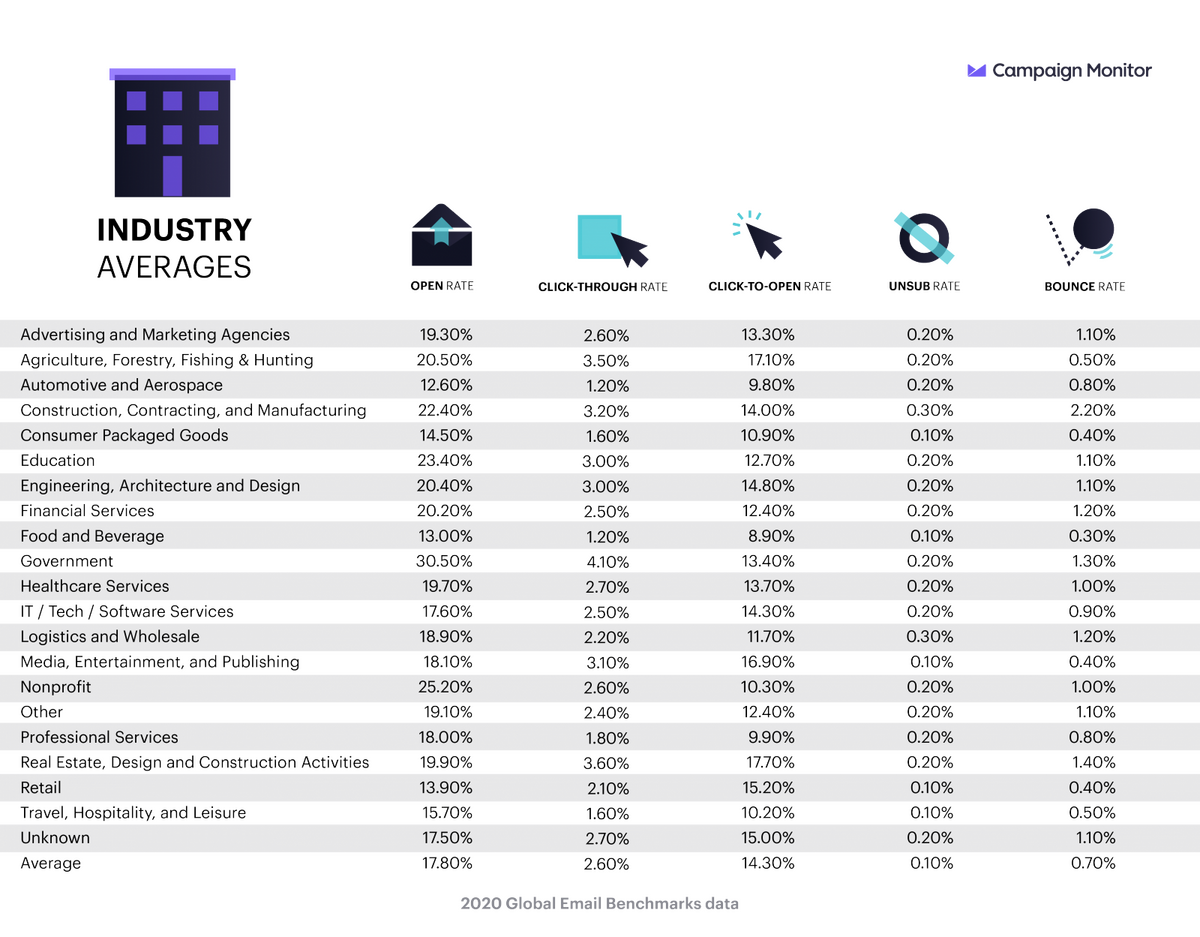
Despite the numbers you see in this report, email marketing metrics depend on various factors, including your business size, your mailing list, your unique value proposition, demographics, seasons, etc. It’s okay to know the average showings in your industry, but it’s best to define what a normal open rate, CTR, and CTOR is for your business, and improve your email campaigns with that data.
Let’s finish this guide with some actionable tips.
4 Best Practices to Improve Your CTOR
- Send Relevant Emails
- Remove Unengaged Subscribers
- Use Email Design Hacks
- Use Active Language
To improve your click-to-open rates, you need to work hard on the overall quality of your email content. The four following best practices will help you achieve that goal.
Send Relevant Emails
Collect user data to send personalized and relevant emails to your audience. Find out users’ engagement level, buyer’s journey stage, demographics, and behavior patterns. Based on user actions, like cart abandonment, you can send triggered emails that help you automatically return clients to shopping with your brand.
Here’s an abandoned cart email flow created with SendPulse. Messages are connected in a series, and each email is automatically sent after a predefined period based on user behavior.
Creating such an email only takes four steps with SendPulse. Here they are:
- Create an event and place the code we generate on your website;
- Create email templates;
- Set up a series of emails;
- Add previously created templates to every email in the flow.
Here’s an email from Adidas. It has a hilarious heading “Is your WI-FI okay?” and appeals to users’ emotions with social proof — the photos of the product generated by other shoppers.

Remove Unengaged Subscribers
Inactive subscribers are useless for your business. You only waste resources by sending emails that they won’t read or click through. To identify unengaged subscribers on your email list, segment your audience based on engagement level. Next to the segments of engaged users, you will have one with subscribers that have been inactive in recent months.
Reach out to them for the last time and ask if they want to stay in touch with your brand. Such a message is called a re-engagement email. Remove those who ignored this email from your list, and start nurturing those who opened.
Here’s a re-engagement email from SkillShare. It aims at returning Premium users with a beneficial, time-sensitive offer and reminds them about all features available for such users.
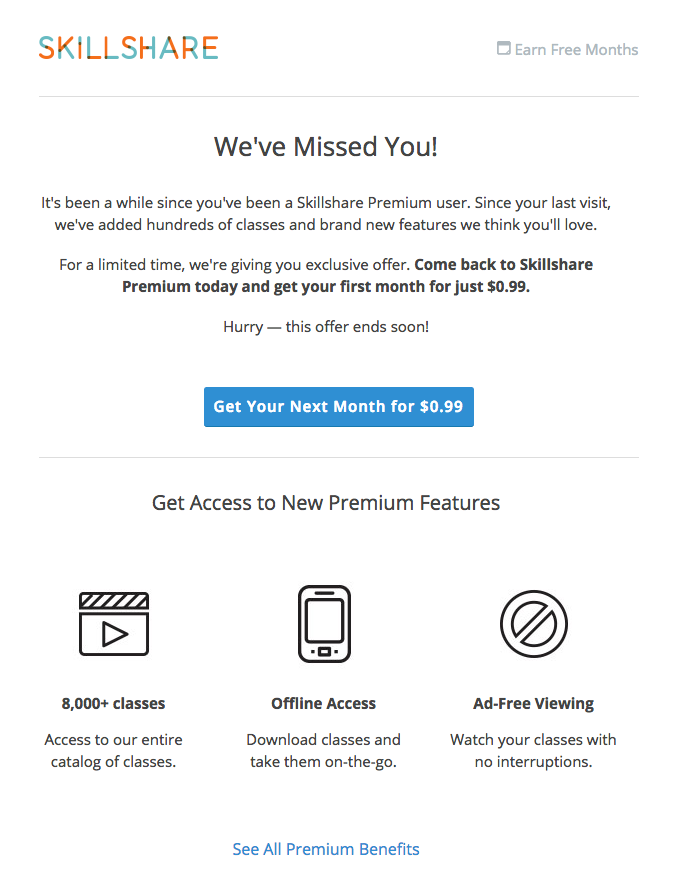
Use Email Design Hacks
CTOR helps you check how effective your email design is. Here’s what you need to do to make your emails look professional and trustworthy:
- Make use of ready-made email templates. With SendPulse, you can use over 130 pre-designed responsive templates. Select one based on your goal and customize it to your liking. Another option is to use our drag and drop editor to create stunning email templates.
- Master mobile-friendly email design. Make your email width 600px, use a short subject line, stick to a single-column layout for your email to be easy to read. Optimize your images for faster loading. Use 13-14px font size so that users can easily tap the buttons. Leave some white space around the CTA to make it more eye-catching. Avoid placing links and menu bars as they are too difficult to tap on a smartphone.
- Write the subject line properly. Do not use CAPS excessively and note that 30-50 characters is the optimal length for email subject lines since longer ones may not display correctly on tablets and smartphones. Another great option is to use emojis to grab subscribers’ attention and stand out from your competitors in the inbox.
- Add the perfect preheader. It should be short and to the point. Stick to 40-70 characters. Ideally, your preheader and subject line should complement each other
- Craft the ideal footer. An excellent footer should contain the brand’s contact details, links to the “About” and “Privacy Policy” pages on your website, social sharing buttons, and an unsubscribe link. Remeber that the last one should be visible and easy to tap on a smartphone.
Here’s a well-designed email from Sonos. It has quality images of the product in the interior and close-ups. The copy is short, and the font is large, making it easy to digest. The CTAs are also highly-visible.

Check out some email design best practices and improve the visual side of your messages.
Use Active Language
Only write a powerful copy in your emails. Pay attention to your CTAs since they are a critical factor that makes people click-through your email. Use active language in your calls to action, for instance, “Learn more,” “RSVP now,” or “Download the catalog.”
Here’s a great example from a Vanmoof email. It has the classic CTA “Shop now.” It’s yellow and contrasting to the background, and it has a little arrow that draws even more attention to it.
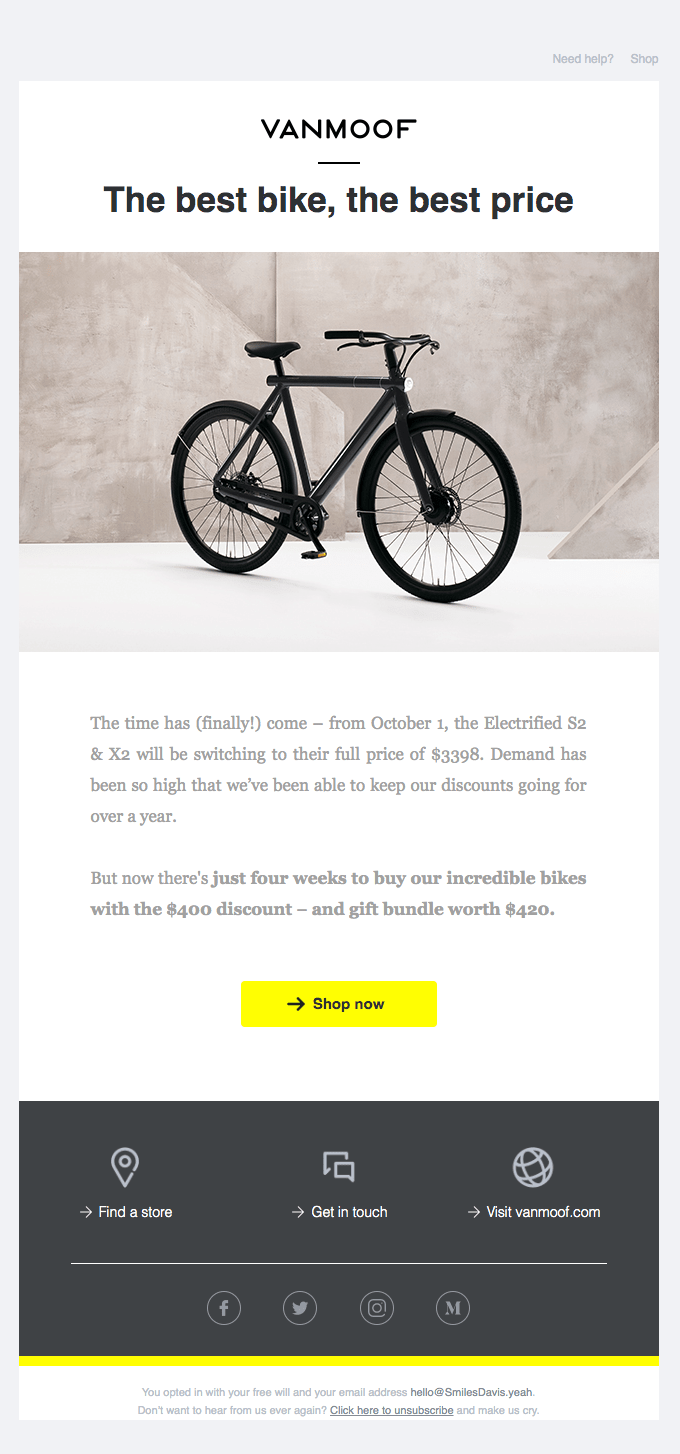
Congratulations, you’ve learned what a CTOR is, why it’s important, and got a few tips on improving this metric and your emails. You can send up to 15,000 emails to 500 subscribers each month at no cost with SendPulse, so check out our service.
Last Updated: 24.09.2024

or